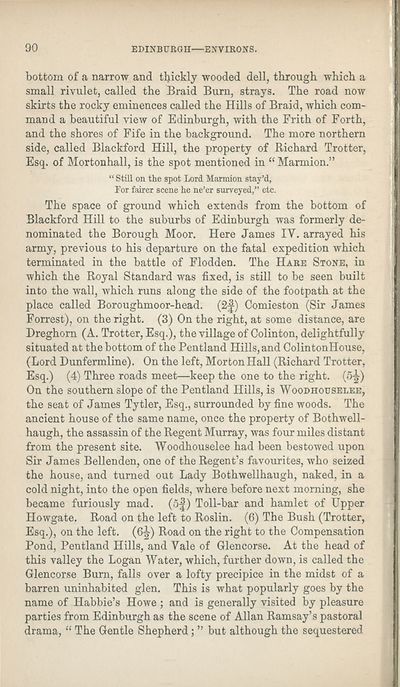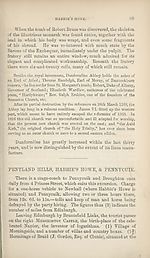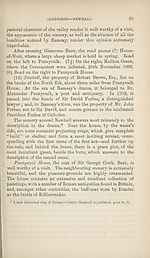Download files
Complete book:
Individual page:
Thumbnail gallery: Grid view | List view

90
EDINBURGH—ENVIRONS.
bottom of a narrow and thickly wooded dell, through which a
small rivulet, called the Braid Burn, strays. The road now
skirts the rocky eminences called the Hills of Braid, which com¬
mand a beautiful view of Edinburgh, with the Frith of Forth,
and the shores of Fife in the background. The more northern
side, called Blackford Hill, the property of Richard Trotter,
Esq. of Mortonhall, is the spot mentioned in “ Marmion.”
“ Still on the spot Lord Marmion stay’d,
For fairer scene he ne’er surveyed,” etc.
The space of ground which extends from the bottom of
Blackford Hill to the suburbs of Edinburgh was formerly de¬
nominated the Borough Moor. Here James IY. arrayed his
army, previous to his departure on the fatal expedition which
terminated in the battle of Flodden. The Hare Stone, in
which the Royal Standard was fixed, is still to be seen built
into the wall, which runs along the side of the footpath at the
place called Boroughmoor-head. (2j) Comieston (Sir James
Forrest), on the right. (3) On the right, at some distance, are
Dreghorn (A. Trotter, Esq.), the village of Colinton, delightfully
situated at the bottom of the Pentland Hills, and ColintonHouse,
(Lord Dunfermline). On the left, Morton Hall (Richard Trotter,
Esq.) (4) Three roads meet—keep the one to the right. (5^)
On the southern slope of the Pentland Hills, is Woodhouselee,
the seat of James Tytler, Esq., surrounded by fine woods. The
ancient house of the same name, once the property of Bothwell-
haugh, the assassin of the Regent Murray, was four miles distant
from the present site. Woodhouselee had been bestowed upon
Sir James Bellenden, one of the Regent’s favourites, who seized
the house, and turned out Lady Bothwellhaugh, naked, in a
cold night, into the open fields, where before next morning, she
became furiously mad. (5|) Toll-bar and hamlet of Upper
Howgate. Road on the left to Roslin. (6) The Bush (Trotter,
Esq.), on the left. (6^) Road on the right to the Compensation
Pond, Pentland Hills, and Vale of Glencorse. At the head of
this valley the Logan Water, which, further down, is called the
Glencorse Burn, falls over a lofty precipice in the midst of a
barren uninhabited glen. This is what popularly goes by the
name of Habbie’s Howe ; and is generally visited by pleasure
parties from Edinburgh as the scene of Allan Ramsay’s pastoral
drama, “ The Gentle Shepherd; ” but although the sequestered
EDINBURGH—ENVIRONS.
bottom of a narrow and thickly wooded dell, through which a
small rivulet, called the Braid Burn, strays. The road now
skirts the rocky eminences called the Hills of Braid, which com¬
mand a beautiful view of Edinburgh, with the Frith of Forth,
and the shores of Fife in the background. The more northern
side, called Blackford Hill, the property of Richard Trotter,
Esq. of Mortonhall, is the spot mentioned in “ Marmion.”
“ Still on the spot Lord Marmion stay’d,
For fairer scene he ne’er surveyed,” etc.
The space of ground which extends from the bottom of
Blackford Hill to the suburbs of Edinburgh was formerly de¬
nominated the Borough Moor. Here James IY. arrayed his
army, previous to his departure on the fatal expedition which
terminated in the battle of Flodden. The Hare Stone, in
which the Royal Standard was fixed, is still to be seen built
into the wall, which runs along the side of the footpath at the
place called Boroughmoor-head. (2j) Comieston (Sir James
Forrest), on the right. (3) On the right, at some distance, are
Dreghorn (A. Trotter, Esq.), the village of Colinton, delightfully
situated at the bottom of the Pentland Hills, and ColintonHouse,
(Lord Dunfermline). On the left, Morton Hall (Richard Trotter,
Esq.) (4) Three roads meet—keep the one to the right. (5^)
On the southern slope of the Pentland Hills, is Woodhouselee,
the seat of James Tytler, Esq., surrounded by fine woods. The
ancient house of the same name, once the property of Bothwell-
haugh, the assassin of the Regent Murray, was four miles distant
from the present site. Woodhouselee had been bestowed upon
Sir James Bellenden, one of the Regent’s favourites, who seized
the house, and turned out Lady Bothwellhaugh, naked, in a
cold night, into the open fields, where before next morning, she
became furiously mad. (5|) Toll-bar and hamlet of Upper
Howgate. Road on the left to Roslin. (6) The Bush (Trotter,
Esq.), on the left. (6^) Road on the right to the Compensation
Pond, Pentland Hills, and Vale of Glencorse. At the head of
this valley the Logan Water, which, further down, is called the
Glencorse Burn, falls over a lofty precipice in the midst of a
barren uninhabited glen. This is what popularly goes by the
name of Habbie’s Howe ; and is generally visited by pleasure
parties from Edinburgh as the scene of Allan Ramsay’s pastoral
drama, “ The Gentle Shepherd; ” but although the sequestered
Set display mode to:
![]() Universal Viewer |
Universal Viewer | ![]() Mirador |
Large image | Transcription
Mirador |
Large image | Transcription
| Antiquarian books of Scotland > Scotland/Scots > Black's picturesque tourist of Scotland > (146) |
|---|
| Permanent URL | https://digital.nls.uk/130029942 |
|---|
| Description | Thousands of printed books from the Antiquarian Books of Scotland collection which dates from 1641 to the 1980s. The collection consists of 14,800 books which were published in Scotland or have a Scottish connection, e.g. through the author, printer or owner. Subjects covered include sport, education, diseases, adventure, occupations, Jacobites, politics and religion. Among the 29 languages represented are English, Gaelic, Italian, French, Russian and Swedish. |
|---|

